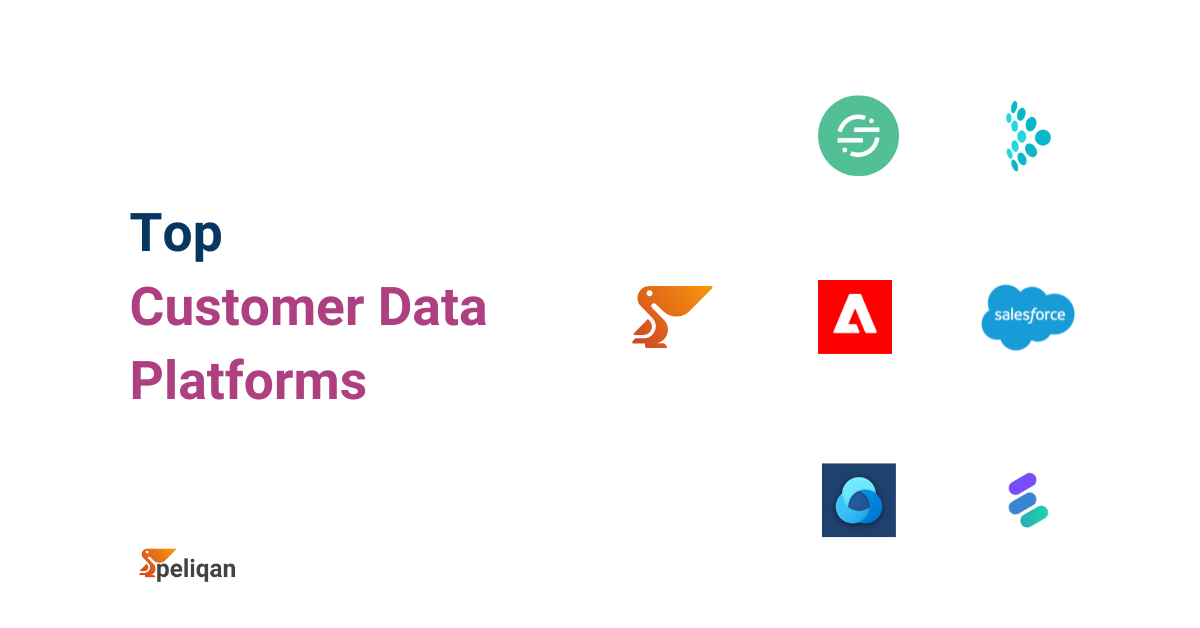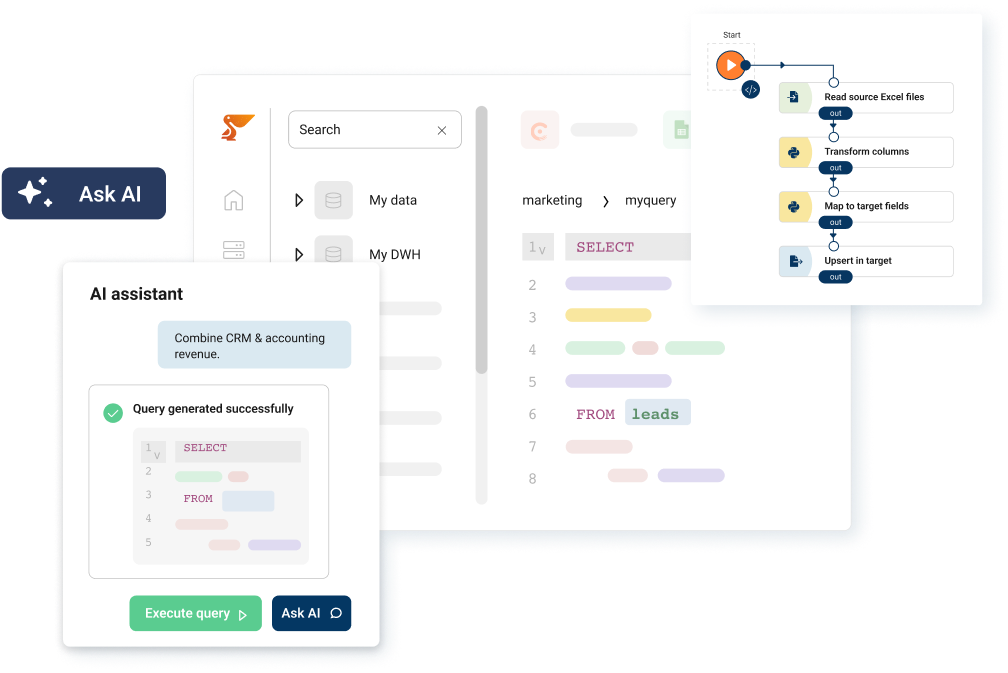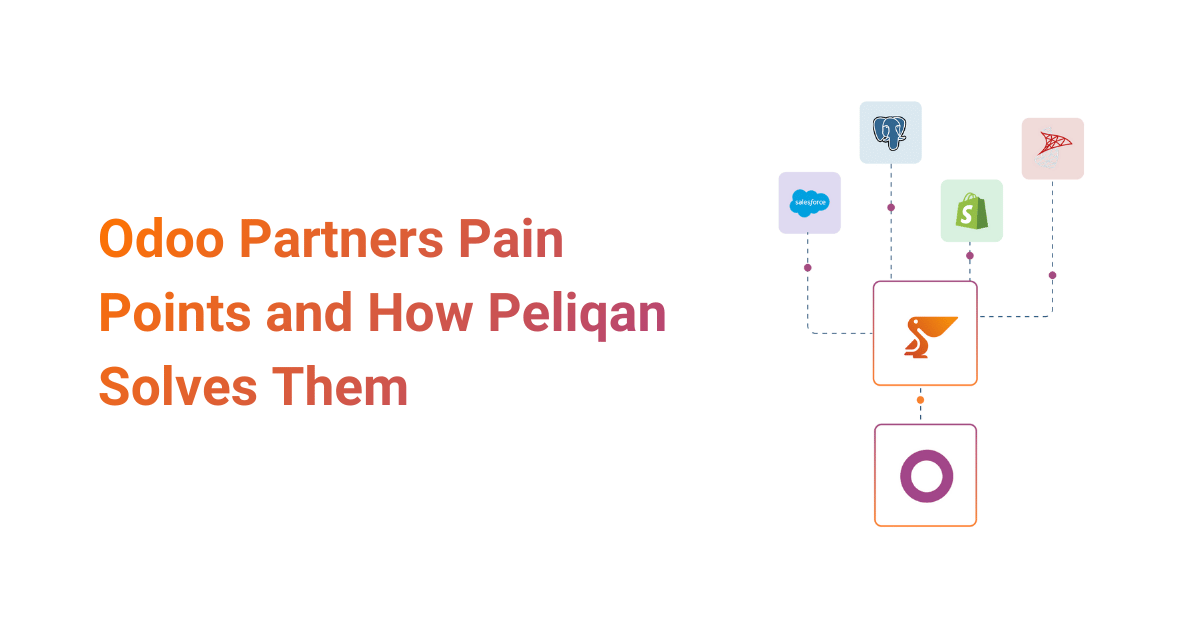CDPs have emerged as essential tools for businesses aiming to unify customer information and power personalized marketing. A CDP collects, aggregates, and organizes first-party customer data from all touchpoints into a single, unified database. This “single source of truth” enables teams to build complete customer profiles and deliver one-to-one experiences across channels.
The global CDP Market size is projected to grow from $7.4 billion in 2024 to $28.2 billion by 2028 at a compound annual growth rate (CAGR) of 39.9%. Industry research also shows concrete ROI: 89% of companies using CDPs report increases in online sales, and 88% see better upsell/cross-sell performance. These trends underscore why modern marketers and data teams are investing in CDPs.
CDPs ingest data from diverse sources into a unified repository, then apply processing, identity resolution, and analytics layers to enable personalized activation. In practice, a CDP connects to databases, cloud storage, web/mobile apps, CRM systems, and more. It ingests raw customer events (page views, purchases, support calls, etc.), resolves identities across devices, and enriches profiles with demographic or behavioral attributes.
Why Invest in a Customer Data Platform?
4 reasons why you invest in a CDP:
- Unified Customer Profiles: CDPs aggregate first-party data (CRM records, website events, mobile app behavior, email interactions, support tickets, etc.) into a single customer profile. This solves data silos and enables consistent targeting across marketing and service teams.
- Streamlined Data Integration: CDPs act as a central hub to integrate data from dozens of sources (databases, SaaS apps, analytics tools) without custom engineering. They simplify data pipelines and reverse-ETL, so insights flow automatically back into CRM, email, ad platforms, etc.
- Data Governance & Compliance: Modern CDPs include built-in data cataloging, lineage, and privacy controls. They help ensure data quality and adhere to regulations like GDPR by unifying consent management.
- AI and Analytics Ready: By exporting unified data to BI tools or connecting with a product recommendations engine, enterprises can anticipate customer needs, automate decision-making, and deliver personalized recommendations with greater precision and scale.
By layering data ingestion, storage, governance, and analytics (as shown above), organizations gain a holistic view of each customer. Below we explore top customer data platforms on the market today and discuss their key capabilities.
Top Customer Data Platforms (CDPs) in 2025

Customer Data Platforms (CDPs): Top 7
The right Customer Data Platform can unlock 360° customer visibility, real-time personalization, and smart activation. Below are 7 top CDPs – tailored for data-driven startups.
1. Peliqan – All-in-One Platform
Peliqan is an all-in-one data platform designed for startups, agencies, and mid-market teams to unify & activate customer data without complex engineering. Businesses can connect Peliqan to multiple databases, data warehouses, cloud storage, and SaaS apps for a truly centralized customer view.
While not a traditional CDP, Peliqan enables core CDP capabilities – from data ingestion to identity resolution – with a low-code UI and advanced integrations.
Core Capabilities and Differentiators
- Spreadsheet-like interface for exploring and transforming customer data
- Connects to 250+ sources including CRMs, databases, web/app analytics
- Built-in data catalog and lineage tracking for governance
- Low-code apps for audience segmentation and reverse ETL activation
- Auto-sync data to marketing tools, CRMs, or internal dashboards
Best for:
Small to mid-size companies and agencies needing a unified CDP without hiring data engineers. Its user-friendly design means marketing or operations teams can onboard quickly. Fast setup. No engineering dependency.
2. Twilio Segment – Developer-Friendly CDP
Segment is a popular developer-friendly CDP. It excels at collecting and routing event data from websites, mobile apps, and servers. Segment provides hundreds of SDKs and integrations, making it easy for engineering teams to capture first-party data in real time. Once in Segment, data can be forwarded to analytics tools, marketing platforms, or data warehouses.
Key Features
- Developer SDKs: Easy to instrument apps and track events.
- Integrations: 300+ integrations (“destinations”) including Google Analytics, Salesforce, Snowflake, etc.
- Data Transformation: SQL-based functions to clean and normalize data as it flows.
- Identity Resolution: Merges events into unified profiles with multiple identifiers.
Best for:
Tech startups and SaaS companies with engineering teams. Ideal when you need powerful event collection and a large ecosystem of integrations.
3. Tealium – Real-Time CDP for Enterprise Personalization
Tealium offers an enterprise-grade Customer Data Hub that combines tag management, an API hub, and a CDP. Tealium’s CDP (formerly Tealium AudienceStream) is renowned for real-time segmentation. It can ingest data from web/mobile tags and any server-side source, then build enriched customer profiles on the fly.
Key Features
- Real-Time Segmentation: Define audiences using on-the-fly criteria (e.g. “Visitors who bought item X and visited Y”).
- Integrations & API Hub: Connects to hundreds of marketing tools. Tealium’s APIHub facilitates data exchange between cloud apps.
- Action-Based Triggers: Automatically trigger actions (like email sends or ad campaigns) when profiles meet certain conditions.
- Data Privacy Controls: Robust consent tracking and data obfuscation features.
Best for:
Large enterprises with heavy web/mobile traffic. Especially useful if you already use Tealium iQ Tag Manager.
4. Adobe Real-Time CDP – Part of Experience Cloud
Part of Adobe Experience Cloud, the Adobe Real-Time CDP brings together Adobe Analytics, Marketo Engage, and more. It’s built to leverage Adobe’s marketing suite and data sources. Adobe’s platform focuses on Real-Time Customer Profiles, combining online and offline data into a persistent profile.
Key Features
- Source System Connectors: Ingests data from Adobe Analytics, AEM, external CRM/ERP systems, etc.
- Profile Stitching: Uses AI-powered identity graphs (Adobe Sensei) to merge data points.
- Segment Builder: GUI for marketers to create target audiences across Adobe channels.
- Activation: Natively pushes segments to Adobe Campaign, Target, and Advertising Cloud for personalized delivery.
Best for:
Organizations heavily invested in Adobe products. It provides deep integration for marketers using Adobe’s campaign, analytics, and content tools. Beyond analytics, Adobe also empowers creators with AI-driven content tools like the Adobe Express voice generator AI, which helps marketers produce natural-sounding voiceovers for videos, campaigns, and presentations directly within its ecosystem.
5. Salesforce Data Cloud – CRM-First CDP
Salesforce Data Cloud (part of Salesforce Customer 360) is a CDP that unifies data from Salesforce CRM, Service Cloud, Pardot, and external sources. It focuses on making Salesforce’s own product data usable for personalization. Consulting partners like ThinkBeyond often help enterprises implement Data Cloud to extend its unified data capabilities across complex, multi-cloud environments.
Key Features
- CRM-Integrated: Leverages existing Salesforce records (Leads, Contacts, Sales transactions) for identity resolution.
- Audience Studio: Marketers create Audiences and activate them directly in Salesforce Marketing Cloud.
- Predictive Modeling: Einstein AI tools for churn, lifetime value, and recommendations.
- Security & Compliance: Built on Salesforce’s robust cloud security.
Best for:
Businesses using Salesforce’s suite of products. Great for aligning sales and marketing around unified customer segments.
6. Microsoft Dynamics 365 Customer Insights
Customer Insights is Microsoft’s CDP solution, part of the Dynamics 365 suite. It ingests data from Dynamics CRM, Microsoft stores/logistics, and third-party apps to build a 360° customer view with AI-driven insights.
Key Features
- Prebuilt Connectors: Pulls data from Dynamics 365 Sales, Marketing, Commerce, plus Azure Data Lake.
- AI Enrichment: Uses Azure AI services for sentiment analysis, segmentation, and propensity scoring.
- Power Platform Integration: Connects to Power BI for analytics and Power Automate for workflows.
- Flexible Data Storage: Can use Azure storage or bring your own data lake.
Best for:
Enterprises already on Microsoft’s ecosystem (Azure and Dynamics). It simplifies analytics and activation using Microsoft AI and Power Platform tools.
7. Lytics – Predictive CDP for Marketers
Lytics is a marketer-friendly CDP designed for segmenting audiences and powering personalized marketing campaigns. It emphasizes ease of use and integrates with email, advertising, and personalization tools.
Key Features
- Predictive Segmentation: Identifies high-value audiences using built-in machine learning.
- Real-Time Behavior Tracking: Collects web and mobile analytics to update segments instantly.
- Omnichannel Activation: Native integrations to CDPs, email (Mailchimp, Smartlead, Marketo), and ad platforms.
- Visitor Analytics: Measures engagement of segments across channels.
Best for:
Mid-market B2C and e-commerce brands focusing on marketing personalization without heavy IT involvement.
Each of these platforms offers unique strengths. When evaluating a CDP, consider your data sources (e.g. CRM, ecommerce, support tickets), integration needs, team skillsets, and budget. Most CDPs follow a subscription pricing model that can range from a few thousand to tens of thousands per month, depending on data volume and features.
Customer Data Platforms Comparison
How to Choose the Right CDP
Choosing a CDP is about matching capabilities to your use cases and data environment. Keep these factors in mind:
- Use Case Priorities: Are you focusing on advertising retargeting, email personalization, customer analytics, or all of the above? Prioritize platforms that excel in your most important use cases (e.g. Tealium for real-time web personalization, Salesforce Data Cloud for CRM-driven marketing, etc.).
- Integration Requirements: Inventory your data sources (e.g. Shopify, Stripe, Zendesk, in-house DBs) and ensure the CDP has connectors or an API to ingest them. CDPs like Peliqan and Segment make it easier to bring in custom data.
- Identity Resolution Needs: Look for robust identity matching if you need to unify user profiles across devices (mobile, desktop) and channels (online, in-store).
- Ease of Use vs. Customization: Platforms like Peliqan and Lytics emphasize self-service for marketing teams, while enterprise CDPs (Adobe, Tealium) often require more technical setup but offer deep features.
- Scalability & Performance: Consider data volume and query performance. If you have millions of users or billions of events, ensure the CDP scales (many are cloud-native but architectures vary).
- Privacy & Compliance: Evaluate built-in tools for consent management, anonymization, and compliance with GDPR/CCPA. This is critical if you handle personal customer data.
Here’s a quick comparison table highlighting some differences:
Conclusion
For startups and agile teams, customer data is more than just a record – it’s a growth engine. A modern Customer Data Platform (CDP) helps you transform fragmented data into rich customer profiles, enabling personalized experiences, smarter campaigns, and real-time analytics.
While enterprise CDPs often come with complexity and cost, tools like Peliqan democratize the CDP experience – providing powerful data integration, activation, and governance capabilities in an intuitive, spreadsheet-like interface. Whether you’re building your first customer 360 view or optimizing multi-channel engagement, your CDP stack should scale with your business, not slow it down.
Startups don’t need to settle for limited features or disconnected tools. With platforms like Peliqan at the center, you can stitch together data, power your marketing automation, and stay privacy-compliant – without hiring a full data engineering team.
Ready to activate your customer data? Start your journey with Peliqan and explore how unified, actionable data can transform your growth strategy.




